Optimizing Your International Student Communication Plan

In order to make worthwhile connections with prospective international students, it’s essential to develop a complete communication plan. Before you can have a complete communication plan, you will first want to understand and explore the different digital methods of communication commonly used by higher education institutions to keep in touch with prospective students and move them through the admissions funnel. Core methods often include social media, email, and WhatsApp. In this article, we’re going to show you the best practices for initiating communication and following up through these methods.
What is WhatsApp?
WhatsApp is a free text and voice messaging app that allows its users to communicate with anyone from around the world. It’s basically like having a phone number that works strictly through WiFi and cellular data instead of using a phone service provider.
Including WhatsApp in Your Communication Plan
WhatsApp has a large number of international users from all over the world, including prospective international students. In order to correctly integrate WhatsApp into your communication plan, you’re able to create a free WhatsApp business account. Creating a business account will allow you to manage your account in a way that the typical WhatsApp user doesn’t have access to. Here are some features of WhatsApp Business that you’ll want to take full advantage of:
Auto-Reply and Text Templates
Since you’ll be communicating with students in different time zones and won't always be available to respond to each message, this feature will come in handy. You can personalize your auto-reply to fit your style and it may be a good idea to include your hours of business so students will know when to expect a response.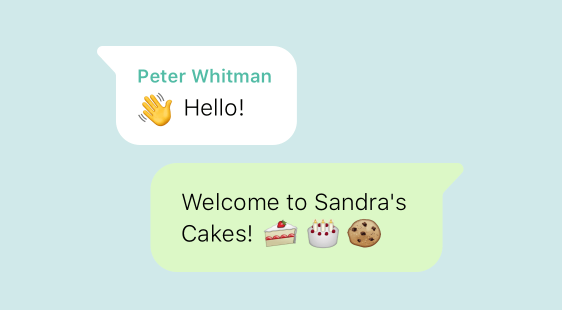
Labels
These will allow you to organize your contacts with up to twenty efficient color-coded tabs. For example, you might have a label for students in different stages of the funnel.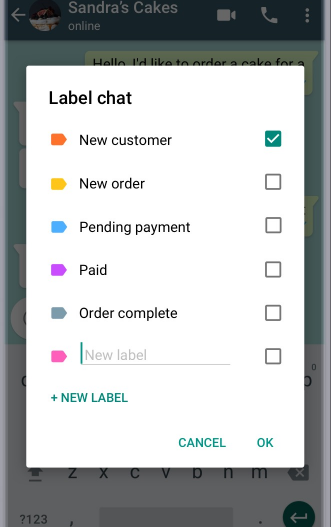
Quick Replies
These are pre-saved messages that you can reuse frequently so you don’t have to repeatedly type out the same message. For example, if you receive a lot of questions about financial aid, you can use a pre-saved template to direct the student to the correct department.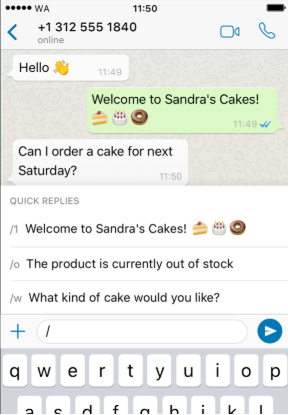
Once you have all of these features set up, you can start planning how to optimize WhatsApp to fit into your communication plan. Some of the best ways to do this include:
Promoting your school - WhatsApp offers a quick and easy way to get in touch with prospective students. This can be done with a quick and easy mass IM to your contacts. By using a broadcast list, you can send the same exact message to several people without having to start a group chat. The first message you will want to send is an introduction that includes a clear next step they can take. Make sure prospective students know who you are, what you do for your school and how to contact you. After, consider sending messages regularly about your school's programs, rankings, extracurricular activities, etc. to keep your leads interested.
Regularly checking and responding to messages - You don't want to keep your leads waiting too long for a response. Set aside some time to check and respond to messages on a regular basis. Depending on how many messages you receive, you might want to do this daily or every other day.
Being personable - While the auto-reply and quick response messages will definitely come in handy, you'll want to make sure that you’re also taking the time to write your own personalized responses when possible.
Following up - When you initiate conversations on WhatsApp, you might not immediately receive a response. If this is the case, we recommend that you take the time to send a follow up message.
Including Email in Your Communication Plan
With email users expected to rise to 4.48 billion by 2024, according to Statistica, you’re definitely going to want to make the best use of this channel of communication. Through email, we recommend sending a sequence of emails with the first welcome email having a very clear call to action.. Not only is this way of communication expected to grow, it’s a highly effective way to get prospects to take the next step.
Let's get started with the basics of email communication with examples of each of the items mentioned above.
The Lead Nurturing Welcome Email
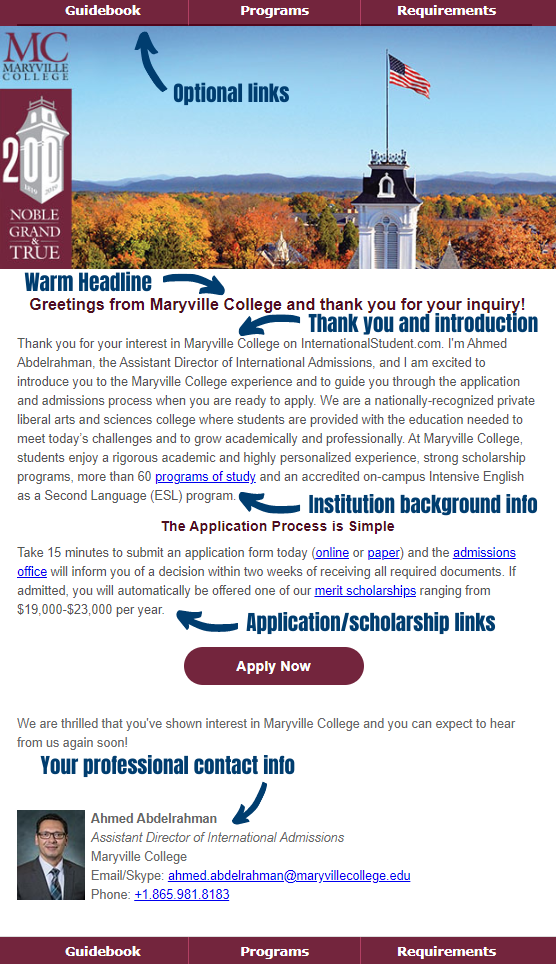
The lead nurturing welcome email is the first message in the series that we recommend sending to prospective students after you’ve received lead information. Sending this message first in the email marketing funnel creates a personal relationship as it will be the students’ first introduction to you and your institution. It will be a personalized message that comes straight from you extending your services and encouraging the student to apply to your institution.
With the welcome email, it’s essential to respond in a timely manner as statistics* show that the quicker you respond, the more likely recipients are to engage with your message:
- One hour response time - 38% engagement success
- Twenty-four hour response time - 8% engagement success
- More than twenty-four hour response time - 5% engagement success
The Email Sequence
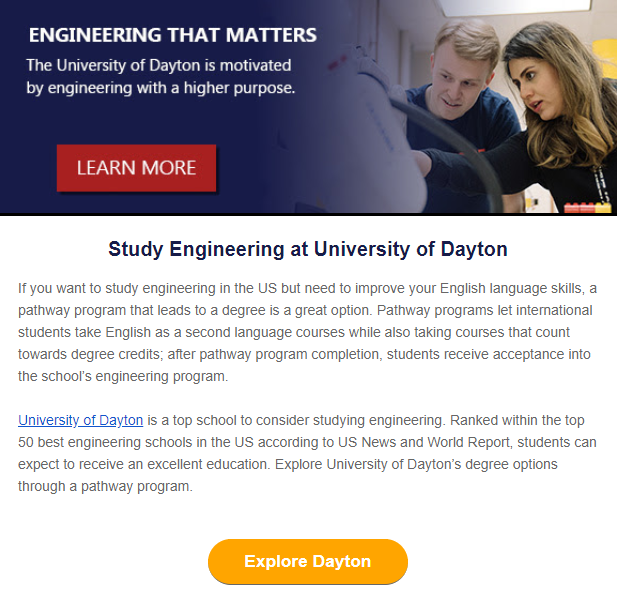
After your welcome email we suggest having at least five more email messages within your communication plan relative to various aspects of your institution. These emails will have a topic of focus such as degree programs as in the above example. Other topics you could focus on in the email sequence include reasons to consider your institution, a virtual tour, extracurriculars, support from staff, etc. The example below shows the number of days doubling with each email, but the time frame each email sends can vary from one sequence to the next; we encourage you to explore and see what time frame provides the best results for you. If you have the ability to automate your sequence, it could look something like this:

Even if you don’t have a way to automate your emails, we still encourage you to create an email sequence and save them as a template.. Set yourself reminders on the day of the send so that you can keep the sequence going and keep your leads engaged. We also recommend contacting your leads at least once per month, monitoring campaign opens, clicks and unsubscribes, and adjusting the frequency of your messages based upon results.
Including Social Media in Your Communication Plan
Chances are your institution is already on social media but how will this fit into your communication plan for the leads you already have? While it is of utmost importance to consistently market on social media, if you’re not using it to connect with prospective students, you aren’t using it to its fullest potential. According to an article written by Adobe the top three social media platforms in 2020 are Instagram, YouTube and Facebook. Each of these platforms can be used for marketing purposes in unique ways. Sending out the right kinds of marketing messages will get students who frequently use social media interested in your institution.
The goal is create posts that will engage your followers, making them want to interact through messages and comments. Once you have engagements, it’s important to know how to respond to them as this will fit into your communication plan. We recommend checking and responding to comments and messages at least every other day. Let's go through each of the social media platforms and how to properly communicate with your followers through them:
-
1. Instagram
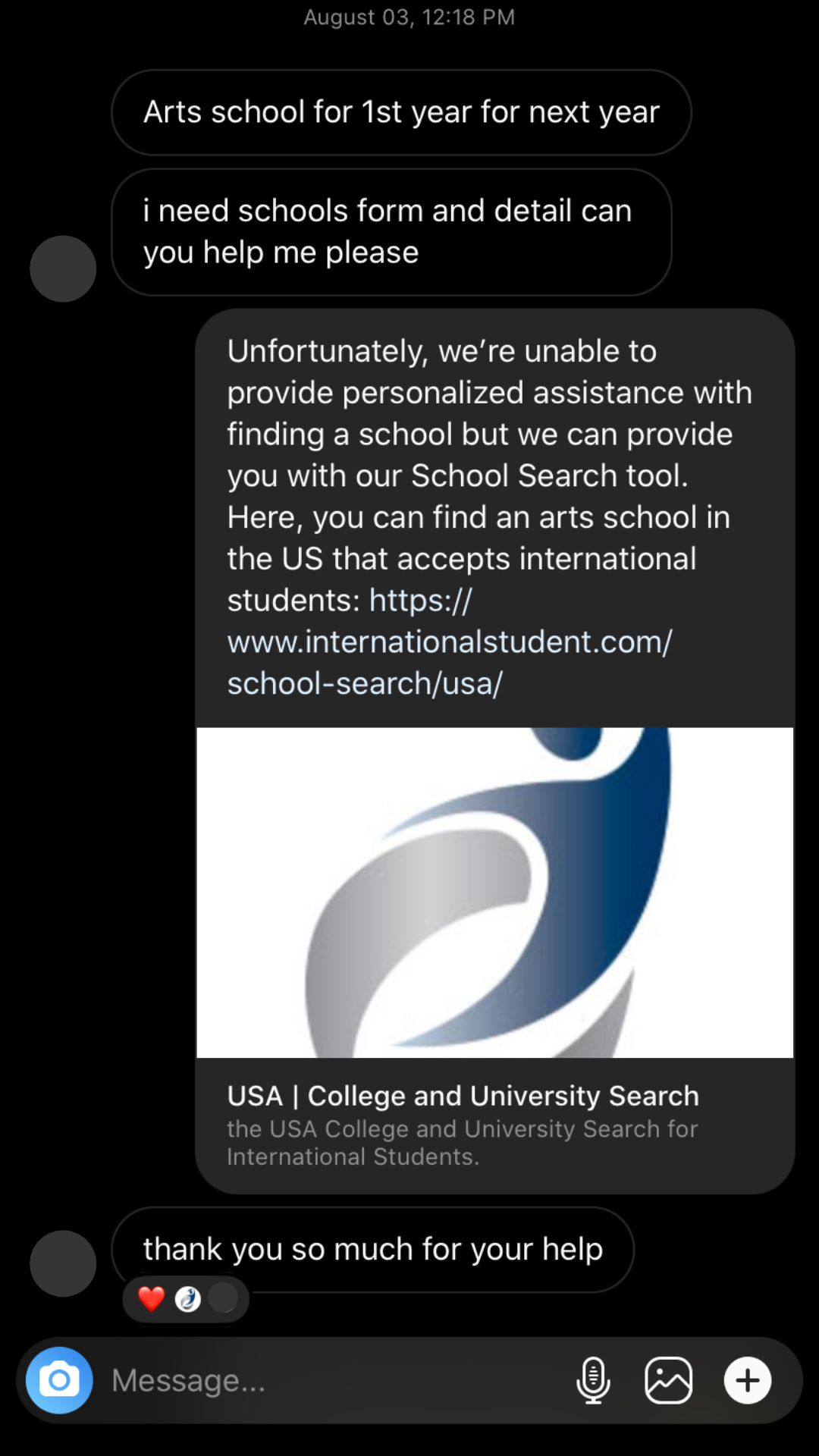
A visual-focused, mobile-only app might not seem like the best tool for your school's marketing strategy. However, with over 1 billion monthly users and a brand-friendly algorithm, Instagram has become the favored platform among digital marketers. To keep prospective students engaged, it's a great idea to ask open-ended questions that encourage direct messages, comments and shares. The admin of your institution's Instagram account should check and respond to comments and direct messages at least once a day.
Here is an example of a direct message conversation between a student and our Instagram admin. The initial message and the response are approximately 25 minutes apart. It’s a good idea to respond as soon as possible to direct messages as this shows the message sender that you care about their question and are interested in helping them find an answer. If the question or request in the message doesn't have a solution, let the sender know in a kind way. However, if you can, always try to provide an answer or solution to the message such as providing a link to your institution’s website as we’ve done with our School Search tool here. Responding timely and adequately to your Instagram direct messages will be greatly appreciated and will show students that your institution is there for support if needed.
-
2. YouTube

We all know YouTube as the go-to platform for content creators and influencers but, like Instagram, it is also excellent for international student marketing with over 2 billion monthly users. Post content on your channel or consider even making a channel for international students specifically to garner interest and to provide additional resources. For example, having an instructional video on your channel for the application process could potentially decrease the need for additional support if the video is sent to students along with the application. Several institutions are also going virtual with campus tours. Take a look at this example from the University of Colorado Boulder.
If your content is engaging to users, you might start to see a number of comments on your videos. Be sure to have someone on your team take time to view these comments and answer any questions about the content in the video or about your institution in general. It’s a good idea to provide relative links in the description of your video and in your responses to questions in the comments section.
-
3. Facebook
Facebook was one of the first social media platforms to exist and today it’s still going stronger than ever with about 2.5 billion monthly users. There are so many features that work to your institution's favor on Facebook from polls to livestreams. It's fantastic for user engagement if you are posting the right content. Recent research shows that posts with video are the most popular across Facebook. Consider having a Facebook Live event for your prospective students and encourage them to join and ask questions. Live events make for great conversation starters and assist in spreading awareness of your institution.

Like Instagram, we suggest allowing people to send messages to your institution's page. To do this, you'll need to turn on Messenger.
We recommend having someone on your team check your institution's Inbox at least once a day. With a response rate of 90% or more and a response time of less than 15 minutes, your page will have a "Very responsive to messages" badge.
Need Help?
If you would like assistance with your communication plan or reaching more prospective students, we are glad to help. Send an email to info@internationalstudent.com to learn more about how our Featured School Packages and Lead Generation can help you with your international student communication plans.
*Statistics for welcome email engagement from VanillaSoft
